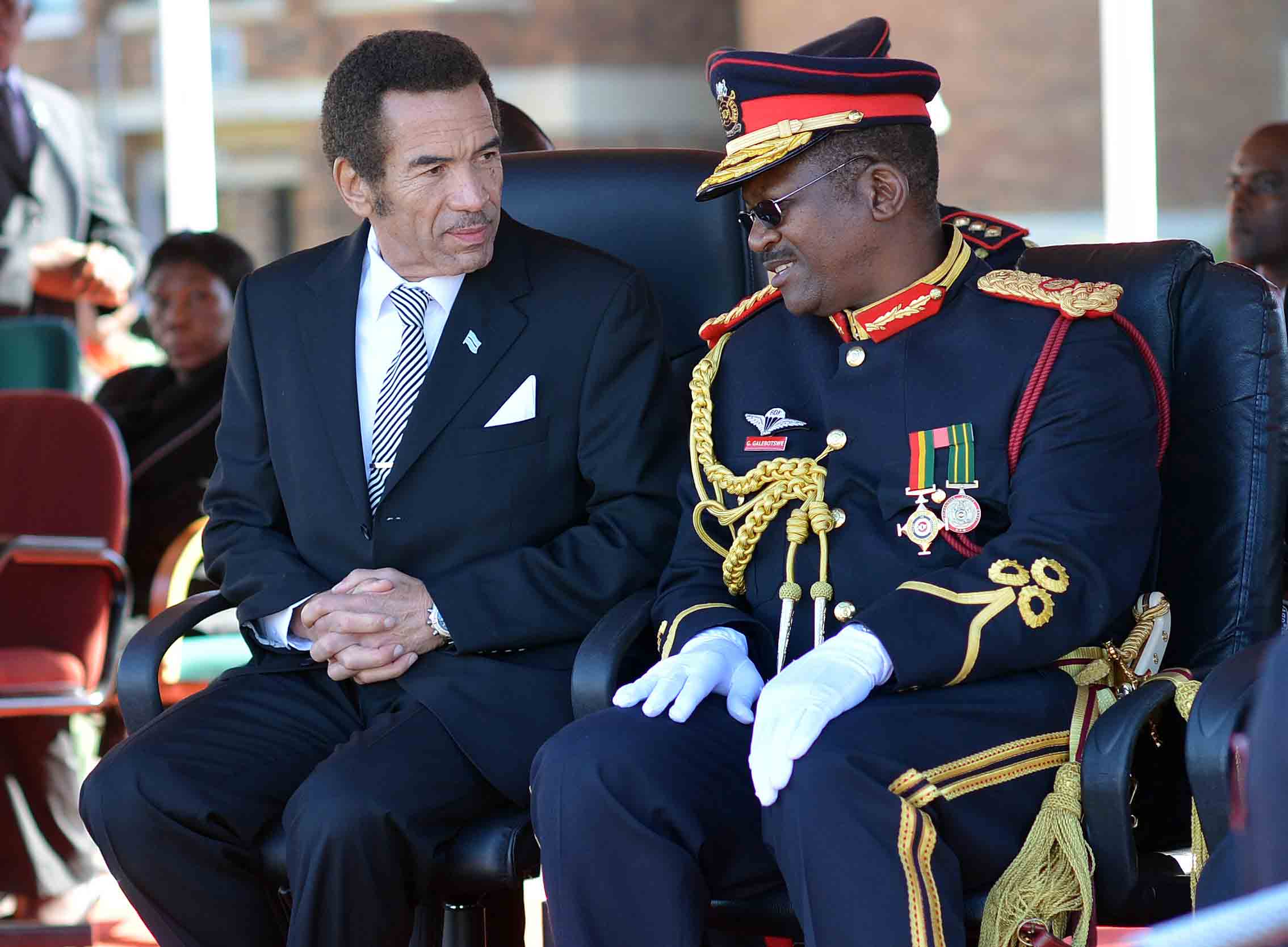- Retired BDF generals Khama and Galebotswe heap blame on national intelligence agencies for poached rhinos and elephants
- According to Galebotswe, the BDF never adopted a shoot-to-kill policy
- Says BDF, wildlife department clashed over proliferation of military camouflage uniforms
TEFO PHEAGE
The Botswana Defence Force’s second and fifth commanders, General Ian Khama and General Gaolathe Galebotswe, have come down hard on the country’s intelligence community, accusing them of failing the nation in the war against poachers, especially the highly protected rhino.
In separate interviews with this publication, both men blamed the intelligence community for the mess that the country finds itself in, saying the question that we should be asking ourselves is: Where is the intelligence community and what have they been doing? Poaching, they say, is an increasingly problematic issue for the intelligence community due to the powerful individuals involved and the increase in their sophistication.
The problems of poaching currently facing this country are worrisome. “Where is the intelligence community? One would assume that they should be leading strategies and assisting in detection and explaining patterns. But they are nowhere to be seen. Poaching is a crime and the intelligence community should be in the lead providing answers,” said Khama, who is also a former president.
Khama said it was embarrassing that instead of pouncing on the problems, the country’s leadership is looking for scapegoats to divert attention from its failures to combat the poaching problem.
Asked about whether he is aware of insinuations that he is behind the mass poaching of rhinos, Khama responded in the affirmative. “I know,” he said. “It’s nonsense. How can I do that when everybody knows my contribution and affection for this country’s wildlife, as well as its flora and fauna. It’s pathetic and a clear demonstration of failed leadership.”
Khama’s younger brother, Tshekedi, introduced weapons of war to anti-poaching as a minister responsible for wildlife and tourism. Tshekedi also supported the shoot-to-kill policy as an effective means to end poaching.
In a separate interview, General Galebotswe – who was the anti-poaching coordinator for a long time – said nowadays “operations are intelligence-led”. Reiterating Khama’s position, General Galebotswe said the magnitude of the problem points to problems in the nation’s intelligence community. “You want to tell me that with such a versatile intelligence community, we have failed to identify who the culprits are and other details defining them or to close the gaps for a very long time?”, he queried.
“Both the military and national intelligence must account for these and give answers, particularly about rhino poaching because that’s a very painful issue. Anti-poaching intelligence techniques play a large role in terms of devising the best possible intelligence strategy to combat animal poaching. Intelligence-led policing in recent years has been identified as a potentially useful approach to reduce and prevent poaching.”
The BDF former commander expressed a concern with intelligence that he said serve individuals.
“They are not doing the country any justice because they then turn a blind eye on other national areas which need their attention,” he said, adding that the military intelligence is not fit for the purpose and cannot be going after people who steal lion cubs.
Researchers say intelligence-led policing emphasises the collection, collation, analysis and dissemination of actionable intelligence for strategic, operational and tactical police operations to objectively target prolific offenders and disrupt or prevent criminal activity.
Intelligence techniques and technologies are implemented by analysts, rangers, anti-poaching units and governments to combat the growing problem of animal poaching, they say. Crime and intelligence analysis, according to studies, has in recent years gained significant attention from conservationists due to the increasing accessibility and capabilities of various forms of information technology.
In response to wildlife crime, some countries have declared war on poaching. In Botswana, the government announced that it had devised and implemented a controversial ‘shoot-to-kill’ policy in 2013, targeting suspected poachers. The unwritten policy was shrouded in secrecy and to-date the source of its legality and the identity of the person who authorised it also remain a secret. At the time when discussions were heated, critics likened the policy to extrajudicial killing of crime suspects. In anti-poaching operations over two decades, it was documented that 30 Namibians and at least 22 Zimbabweans were killed in Botswana, a situation that nearly erupted into a diplomatic tiff between the affected countries.
But General Galebotswe denied – the existence of the controversial policy. “It was all talk,” he said. “There was never a shoot-to-kill policy that was adopted by the BDF as claimed. I am only speaking from the military side. The BDF is guided by the Orders for Firing Green Book, which is classified and conditions for shooting are clearly stipulated therein. You only shoot at a target or adversary where your life or that of your colleague is danger or the property you are protecting.”
However, he noted that although the BDF emphasises on minimum force, there are inherent engagement orders in any operation that guide rules of engagement. Poaching, the retired general stressed, was where the BDF could not afford to compromise because poachers do not.
The hard line stance on rhinos poachers, General Galebotswe said, was necessitated by the fact that rhinos are an endangered species. “Soldiers must guard jealously against the rhinos and shoot before a rhino is shot,” he asserted. “The problem with today’s military is that they report after the fact. You can never recover the rhino once it is shot.”
The Khamas and certain international pressure groups blame the scourge on the disarmament of the wildlife department by the Masisi administration. But General Galebotswe rubbishes this view as emotional and without any basis. “Look, I know that there are those who ascribe the scourge to the disarmament of the wildlife department,” he said. “I strongly disagree with that view because these areas where poaching is rampant are under the care of the BDF and not wildlife. Rhinos were placed under the BDF’s responsibility because they have the right equipment. It is very clear that there was no legislation accompanying the weapons of war held at the wildlife department and it was wrong.” But is there a need for the department to be armed? “Yes,” came the answer. “If anybody had suggested that they be legally assisted to carry out that, I would have supported it. Poachers have become sophisticated.”
On the type of weapons the wildlife department needs, Galebotswe responded: “They used to carry semi-automatic Smirnoffs and self-loading rifles. They, in my view, certainly need automatics because poachers nowadays carry AK47s. But I disagree that they should have the same weapons as the military.”
There were also concerns and fears that the wildlife department could turn into a militia when they were seen in military camouflage uniforms. Galebotswe confirmed this, saying: “It was a serious issue in the military. We raised the concern with the relevant authority and the challenge was that the military then had not yet defined its camouflage. They (the wildlife department) had already bought a lot of material and the agreement was that it should be used and an engagement would begin after each department had addressed its own issues.”
General Galebotswe noted that the police also previously used camouflage but seem to have abandoned it. The matter seems to have been addressed now and the BDF describes its camouflage pattern as a Disruptive Pattern Material (DPM). Army spokesman Colonel Dikole told The Botswana Gazette: “The main variants of DPM are a four-colour woodland and desert patterns in two, three or four colours,” he explained. “The pantone colours are green pantone 19-0230 TPX (garden green), light brown pantone 16-1126 TPX (antelope), dark brown pantone 19-0815 (desert palm) and black pantone 19-0508 TPX (peat).”
Colonel Dikole added that the pattern was inspired by its level of durability and ability to protect personnel and equipment from observation by adversary forces. Woodland DPM camouflage is the specific pattern used exclusively by BDF and any use of this pattern by members of the public is prohibited and punishable by law under Section 183 (2) of the Penal Code, he explained
“Any person who, without the authority of the persons upon whose application an order under this section has been published in the Gazette, uses or wears any uniform, badge, button or other distinctive mark described in the order, or any uniform, badge, button or other distinctive mark so closely resembling the same as to lead to the belief that it is a uniform, badge, button or other distinctive mark so described, is guilty of an offence and is liable to imprisonment,” the relevant law reads in part.
This is buttressed by Section 272(a) of the BDF Act 2018 that reads: “A person who without authority, uses or wears any service decoration, uniform, or any badge, insignia of rank, wound stripe or emblem supplied or authorised by the President or the Defence Council, commits an offence and shall on conviction be liable to imprisonment for a term not exceeding two years.”
Meanwhile, General Galebotswe spoke of a need for Botswana to have considered the idea of a rhino protection task force. In his view, Botswana seems to have learnt nothing from South Africa when it faced the scourge of rhino poaching. “Poaching is still prevalent in Botswana,” said the retired general. “It has never stopped and signs are that it will not stop now. The black rhino was poached to extinction and the white rhino was poached to near-extinction save for the four surviving which were relocated from Chobe National Park to Khama Rhino Sanctuary. One was named Serondela, which is one of those poached at the (Okavango) delta. Serondela was one of ours which bred in Botswana and was part of us or our national heritage. It’s not an ordinary loss. The argument is now that the relocation for the rhinos to the delta was never safe and I agree with that. It was just a matter of time.”
According to General Galebotswe, politics may also be to blame for the spike in rhino poaching. “There was a time when we argued about a lot of issues in relation to wildlife, the hunting ban, the disarmament of the wildlife department and many other issues,” he said. “These quarrels also had an impact on us and our preparedness. Maybe the poachers took advantage of the quarrels. It is not locals poaching. Foreigners have infiltrated us. It is a national security threat that we should prioritise. Most of these people are the ones lying unidentified in our mortuaries.”
Ivory, specifically, continues to be a coveted item that is rising in value. Renowned New York Times (Africa) wildlife journalist, Jeffery Gettleman, has written that militia and terrorist groups such as the LRA, al-Shabab and Darfur’s Janjaweed are now cited as using ivory and hunting elephants to buy weapons and sustain their operations. This instantly elevates the national security interest in poaching activities. Gettleman notes that poachers are making increasingly complicated connections with organised crime syndicates to move the ivory and are exploiting turbulent states, porous borders and corrupt officials in sub-Saharan Africa and China in this growing crime ring.
General Galebotswe said he also believes that environmental factors like drought were not taken into consideration before the rhinos were relocated. “Rhinos are now covering long distances to seek greener pastures,” he pointed out. “So we also failed to plan ahead to avert these challenges.”




